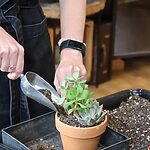Table of Content
About
Sphagnum Moss is a fantastic aid to the avid indoor garden, with many different uses and styles, this plant has become a favourite for uses in terrariums, vivariums, moss poles and top dressing. While this plant is incredibly useful to us houseplant lovers we often know very little about it in the same way we do some of our favourite houseplants.
There are two main types of Sphagnum moss, Sphagnum moss and peat moss, which differ in the way they are harvested but they all fall under the same family with little under 400 species being recognised that makeup Sphagnum moss as a whole. They are all non-vascular plants meaning they don’t have roots, grow flowers or produce seeds. This kind of moss is predominantly found in cold and wet environments in the northern hemisphere where they completely dominate their environment. They can be found in places like marshes, bogs, fens, highlands and forests. What makes moss so dominant is that it can often survive in places where no other plant life could.
What makes Sphagnum moss so useful is its ability to hold water like a sponge, it can hold around twenty times its weight in water due to its cell structure. What also makes this moss so useful is that it has a neutral PH balance which makes it a product very versatile to use. But with these two features combined in its natural environment, they are building blocks for other life. They can influence new environments they reside in by affecting the nutrients, water and PH levels, this allows for vascular plants, plants with roots and stems, to establish themselves in areas that they couldn’t before.
Sphagnum moss is often harvested from ground level and can be used both alive and dried. The level of water retention this moss provides is sought after due to its efficiency. The ability to slowly dispense water to the dry elements surrounding it is invaluable. It can be used for a number of different plants either by itself or as an additive to the soil, it creates a great environment for cuttings and epiphytes that typically do better without soil but still need some shelter and moisture retention. The list goes on and on with use cases for this fantastic plant!
Light
Sphagnum Moss is highly adaptable and is used to a full spectrum of conditions, tolerating full sun to deeper levels of shade. The light conditions will determine what colour your living moss will be and this also is the reason why a different variety of colours are available. The less light it is exposed to the richer and lusher the green appearance will be while high light exposure will bring out a fantastic range of different colours.
Humidity
Sphagnum Moss needs high levels of humidity to survive, without 60% to 80% humidity it will dry out incredibly quickly and start to struggle if left dry in its environment. Regular misting, especially during warmer months, will be essential to keep live moss happy.
This love of high humidity makes them really well-suited to terrariums, vivariums and ecospheres with the addition of creating a really high-quality finish and look. Terrarium Kits – Create your own self-sustaining terrarium with our curated terrarium kits.
Water
Sphagnum moss loves water and should always be moist to the touch. You can regularly mist the moss but a good soak in a shallow tray of water will make it really happy. Allow excess water to drain away.
When living moss starts to dry the tips of the moss will start to turn brown or white. This is a signal to show your moss needs watering.
Soil
Sphagnum moss is a non-vascular plant meaning it has no root system, so when using this moss or trying to propagate in soil it is not necessary to provide water or nutrients to the plant through the soil. Sphagnum moss will absorb both water and nutrients through direct contact. In the wild, they will mainly grow over anything that provides them with enough moisture to stay hydrated.
Feed
Always be careful to not overexpose living sphagnum moss to feeds and fertilisers. They are used to nutrient-depleted areas and often feeding them will cause them harm, they will be able to tolerate very small amounts of diluted feed but as a general rule, too much-concentrated feed will turn the moss into a puddle of slime.
Growing Plants in Sphagnum Moss
There are many great benefits to using sphagnum moss as a growing medium for your plants. Almost all herbaceous houseplants could comfortably make a switch over to a substrate only made up of Sphagnum moss. It is really simple to use and actually in a lot of ways much easier than growing your plants in regular soil.
Sphagnum moss is often paired best with clear pots as this makes it much easier to see when the moss is starting to dry out. When using Sphagnum moss, repot your plants in the same way you would when using soil by surrounding the root system with the moss and lightly compacting it down. After potting, you can soak the moss with water and gently squeeze the pot to get rid of any excess. Because Sphagnum moss can retain more water than soil you will find yourself having to water your plant less. It also helps to raise ambient humidity around the plant and is much less likely to develop pests.
While growing plants like this is not for everyone, this can make a great alternative in higher humidity environments to growing in soil and in most cases if the plant is kept in the same pot for prolonged periods of time, the moss will outperform the soil and last longer before needing to be replenished. There is also a fantastic sweet spot that can be struck up between using a mixture of soil and moss, using moss as a top dressing provides a lot of the same benefits as planting in moss without some of the drawbacks.
Sphagnum moss is also used to create moss poles that can be used to help support a wide range of climbing and naturally vining plants. Moss Poles for Climbing Plants – Support your climbing plants with a moss pole that retains moisture.
Propagating With Sphagnum Moss
Using Sphagnum moss to propagate your plants is really effective and relatively easy. With any cutting you are trying to propagate, nestle it into a small pot of saturated moss and keep them in a humid environment, the less humid the environment the quicker the moss will dry out, so make sure to keep an eye on it. The one thing to look out for when propagating this way is if you are using plants with a thin root system for example Peperomia, Hoya, Maranta etc. As the cutting starts to develop roots they can become matted to the moss which can make it difficult to transfer to large pots. Always ensure when transferring to soil the moss is well-saturated before doing so.
If you enjoyed this guide head over to Articles & Blogs to learn more or check out our YouTube for even more useful information!
Live Sphagnum Moss – Buy high-quality Sphagnum moss for propagation, terrariums, and moss poles.











